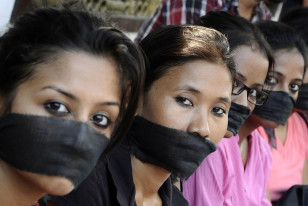
Members of the All Assam Photojournalist Association wear black sashes around their mouths to protest against the rape of a photo journalist by five men inside an abandoned textile mill in Mumbai, in the northeastern Indian city of Guwahati, Aug. 24, 2013. (Reuters)
In an ideal 21st century world, there would be no violence – against women or any other group. The naive assumption would be that social strides would match technological progress going into a more enlightened future. But in this imperfect world, where violence against women remains a real, global phenomenon, technology is coming to the aid of those seeking to end it.
“Technology has really permeated how people are doing their work in this area,” says Joan Libby Hawk, Special Adviser for Women’s Empowerment Principles at UN Women and UN Global Compact Senior Adviser for Futures Without Violence, a non-profit organization dedicated to stopping violence against women. “And I can tell you as someone who has been involved in this work for many years … that is an astounding development,” she added.
Advocacy groups are able to reach many more people via the Internet, social media and mobile devices to alert them about human rights abuses against women and push to change social norms.
Hawk remembers how the 2012 gang rape of a young woman on a bus in India shocked the nation and galvanized people to use the Internet to organize global demonstrations demanding justice and more stringent laws against rapists.
Young people growing up in an increasingly connected world have “different sensibilities,” says Hawk. “They have a much greater sense of empowerment. And the ability to get on the Internet and raise your voice and join advocacy movements and learn about your rights … is a crucial part of it.”
Communication is key for social change, says Hawk, who also serves as a special adviser for The Communications X-Change, a digital global communications library funded by the Avon Foundation as part of a collaboration with the United Nations.
“Avon went ahead and did one before we had the Communications X-Change,” Hawk said “And we talked to them. We put it in the context of doing something that could be global, doing something that utilized technology, doing something that built a knowledge base and raised awareness.”
The Communications X-Change is managed by Futures Without Violence, which collaborated with the Ad Council on the first public service announcement on ending violence against women and was instrumental in developing the Violence Against Women Act passed by U.S. Congress in the 1990s.
Hawk says the group recognized that messages can change behavior and that “changing attitudes and behaviors is critical to actually stopping violence against women.”
Apps for Women
- Circle of 6: An iPhone and Android app that allows women to designate six people to alert when they feel their safety is threatened
- Hollaback: An app that allows users to report street harassment to a local chapter. The collected data is then used for education, raising awareness and additional research.
- Not Your Baby: An iPhone app that suggests ways to respond to sexual harassment and allows users to submit their own ideas and stories.
- Safetpin: An Indian app that helps women keep track of their level of safety and share information about safety and sexual violence.
- We Can! A Singapore-based video to encourage bystanders to stop violence they witness and a Facebook app on different forms of gender violence
Along these lines, a communications award marking International Women’s Day was devised in response to Avon’s interest in Futures Without Violence’ focus on communications as a tool for social norm change and to help launch and promote the website.
“We engineered the communications awards … using this time the Internet as the highway for submissions via the Communications X-Change,” said Hawk.
One of 2014’s Second Annual Avon Communications Awards finalists is SafetPin, an Indian mobile app that allows people to record their level of safety, send information about their neighborhood and talk about safety and sexual violence.
Another finalist is We Can! End All Violence Against Women. The Singapore-based effort is both a video to encourage bystanders to stop violence they witness and a Facebook app on different forms of gender violence.
Circle of 6 is an app that lets people put in the names of six acquaintances they would want to reach when they fear for their safety. “This is especially relevant … in a lot of circles where there are a lot of young people,” says Hawk.
Young people typically prefer not to call the police or even their parents when something goes wrong, says Hawk. “But they will reach out to a peer,” she said. “So this app – Circle of 6 … has been constructed for them to do that.”
These are just a few of the contributions that have been recognized for excellence in communication in the effort to put an end to violence against women. Taken separately, they do not resolve the problem of violence against women. Put together, they are certainly a step in the right direction.

3 responses to “Fight to End Violence Against Women Goes High-Tech”
[…] Fight to End Violence Against Women Goes High-Tech (Voice of America) […]
[…] Fight to End Violence Against Women Goes High-TechVoice of America (blog), on Fri, 14 Mar 2014 11:11:15 -0700Members of the All Assam Photojournalist Association wear black sashes around their mouths to protest against the rape of a photo journalist by five men inside an abandoned textile mill in Mumbai, in the northeastern Indian city of Guwahati, Aug. 24, 2013. […]
Just came across your sight. I have been working in empowering women in Assam, India since 2004. I would love to connect. We host a fundraiser every year and this year, the fundraiser will focus on initiating STEM education for girls in Assam, and training teachers in hands-on teaching techniques. STEM is the academic disciplines of science, technology, engineering and mathematics.